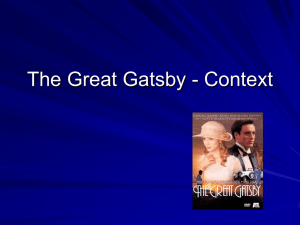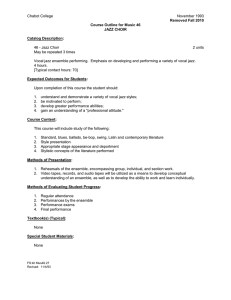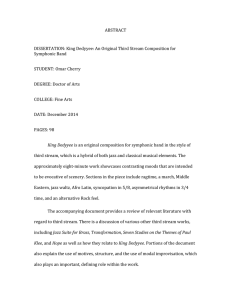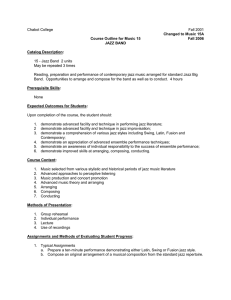Commonwealth of Pennsylvania KUTZTOWN UNIVERSITY Kutztown, Pennsylvania
advertisement
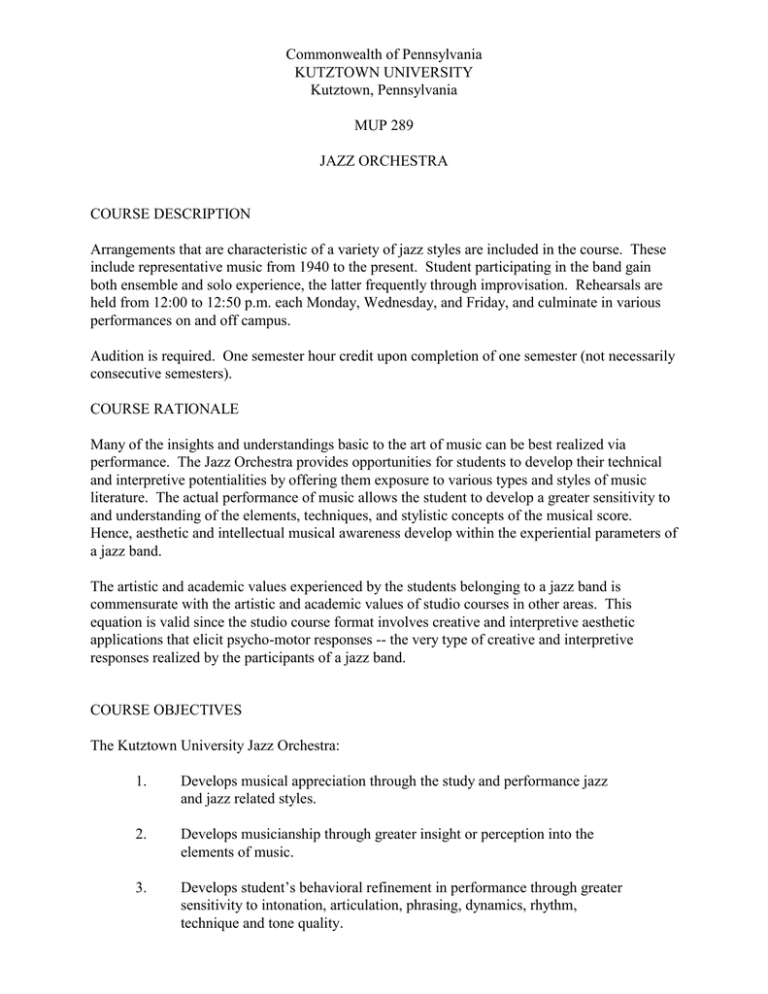
Commonwealth of Pennsylvania KUTZTOWN UNIVERSITY Kutztown, Pennsylvania MUP 289 JAZZ ORCHESTRA COURSE DESCRIPTION Arrangements that are characteristic of a variety of jazz styles are included in the course. These include representative music from 1940 to the present. Student participating in the band gain both ensemble and solo experience, the latter frequently through improvisation. Rehearsals are held from 12:00 to 12:50 p.m. each Monday, Wednesday, and Friday, and culminate in various performances on and off campus. Audition is required. One semester hour credit upon completion of one semester (not necessarily consecutive semesters). COURSE RATIONALE Many of the insights and understandings basic to the art of music can be best realized via performance. The Jazz Orchestra provides opportunities for students to develop their technical and interpretive potentialities by offering them exposure to various types and styles of music literature. The actual performance of music allows the student to develop a greater sensitivity to and understanding of the elements, techniques, and stylistic concepts of the musical score. Hence, aesthetic and intellectual musical awareness develop within the experiential parameters of a jazz band. The artistic and academic values experienced by the students belonging to a jazz band is commensurate with the artistic and academic values of studio courses in other areas. This equation is valid since the studio course format involves creative and interpretive aesthetic applications that elicit psycho-motor responses -- the very type of creative and interpretive responses realized by the participants of a jazz band. COURSE OBJECTIVES The Kutztown University Jazz Orchestra: 1. Develops musical appreciation through the study and performance jazz and jazz related styles. 2. Develops musicianship through greater insight or perception into the elements of music. 3. Develops student’s behavioral refinement in performance through greater sensitivity to intonation, articulation, phrasing, dynamics, rhythm, technique and tone quality. 4. Brings about peripheral objectives in the development of good citizenship through good ethical character and self-discipline. 5. Develops a musical performance literature repertoire. 6. Develops a music performance program that allows for educational interrelationships between college and community. 7. Develops the creative mind to perform extemporaneously through improvisation. COURSE OUTLINE A. Jazz Band 1. History of the Jazz Band Movement a. Dixieland band and the blues of the South b. Jazz band progress up Mississippi to Chicago c. Jazz band spreads throughout United States d. Jazz band in today’s public schools and colleges 2. Instrumentation a. Saxophones, trumpets, trombones and rhythm section b. Strength of individual players and effective depth of sections c. Range of individual’s instrumental capacity with total ensemble’s capacity d. Tone quality of individual with ensemble e. Improvisation by solo performers and total group 3. Seating a. Placement of instruments of sections for total ensemble sound 4. Repertoire a. Type of jazz band literature 1) Stock arrangements 2) Experimental arrangements b. Diversification of styles of jazz literature 1) Blues 2) Dixieland 3) Bop 4) Cool 5) Progressive 6) Rock 7) Free improvisational 5. Individual Development for Group Musicianship a. Quality tone production b. Rhythmic and tonal accuracy c. Good physical habits 1) Good posture 2) Breath support d. Special techniques involved with specific instruments e. Style of performing f. Musical vocabulary g. h. I. 6. 7. Sight reading skill Improvisational ability Rehearsal deportment 1) Attendance 2) Practice 3) Listening 4) Creativity 5) Responsibility to total group and director Improvisation a. Intuition and originality b. Intellectual energy c. Emotional content d. Sense of pitch through development of ear e. Taste f. Construction of chords with sixth, seventh, ninth, etc. (Functional harmony) g. Understanding scales 1) Major 2) Minor 3) Augmented 4) Diminished 5) Modal I. Understand form 1) 32-measure concept with AABA structure 2) Expanded forms from the 32-measure concept j. Creating melodies with rhythm section k. Creating rhythmic patterns with melodic concept l. Creating melodic and rhythmic concepts m. Creating harmonic concepts with total ensemble Evaluation a. b. Student Auditions Performances 1) Solo 2) Ensemble 3) Shows 4) Concerts INSTRUCTIONAL RESOURCES Actual music being performed plus material derived from the following texts: Baker, David. Jazz Improvisation. Chicago IL: Downbeat Publishers, 1969. Coker, Jerry. Improvising Jazz. Englewood Cliffs, NJ: Prentice-Hall, Inc., 1964. Levey, Joseph. Basic Jazz Improvisation. Delaware Water Gap, PA: Shawnee Press, Inc., 1970.
